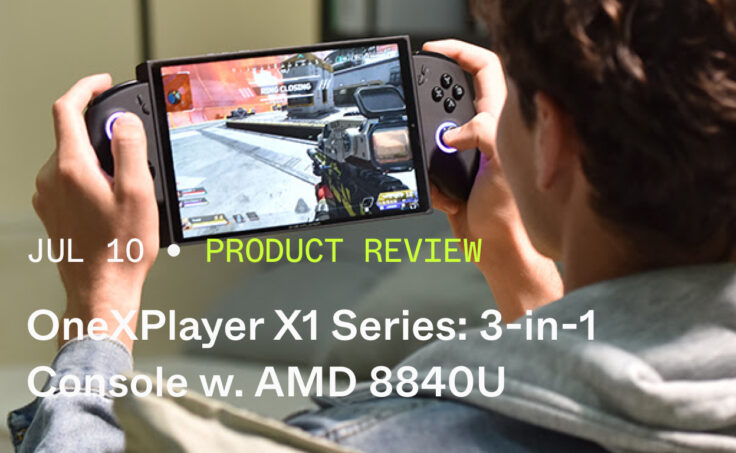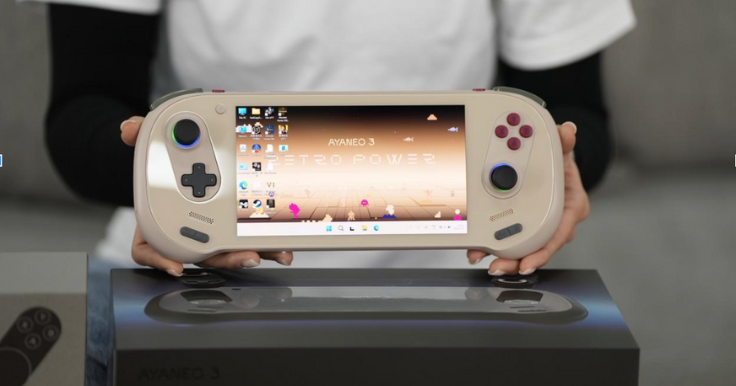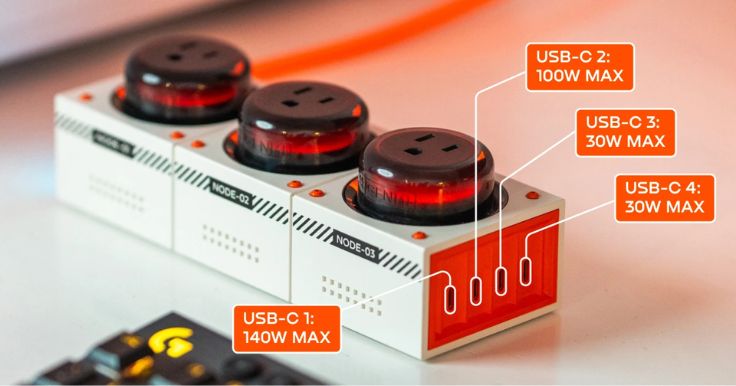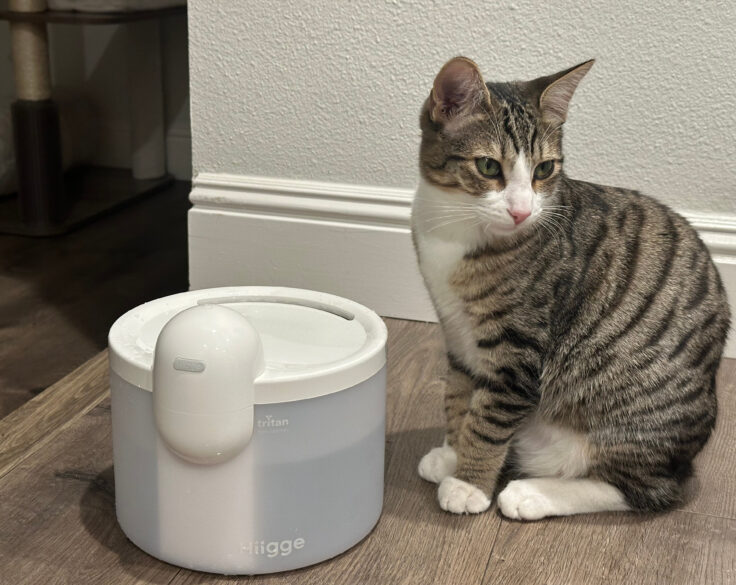Indiegogo staffers are putting crowdfunded products to the test in our new series of honest reviews. In this edition, Mario, our Senior DevOps Engineer, tried out OneXPlayer X1 Series: 3-in-1 Console w. AMD 8840U. Did it meet his expectations? Read on to find out more.
I enjoy gaming, but haven’t played games on a computer since gaming on the Macintosh was a thing (Myst, Lemmings, Prince of Persia, and the like). Lately I’ve been going deep on Zelda: Tears of the Kingdom. I’m looking forward to exploring gaming on this powerful and portable platform!
I’m here writing an unboxing review of one of OneXPlayer’s latest offerings, their X1 gaming handheld with AMD Ryzen™ 8840U CPU. This X1 came with a label on the back indicating: ProtoType. I’m unaware whether or how the particulars of this unit differ from their production units. It also came with their matching gaming controllers and Controller Connector, a detachable magnetic keyboard with trackpad, and magnetic back cover (which they refer to as a Back Bracket).
Unboxing
The OneXPLayer X1 I received for this review was shipped via DHL, and arrived just days after being handed over for transit. It was packaged in pleasing and nicely designed packaging, with ample padding to keep everything safe from any perils of parcel travel, though the keyboard was provided in just a plastic bag with foam padding. Unpacking everything was easy enough, though the box containing the AC Adapter & USB C cable sure was a tight fit in the foam cutout. The black ribbon for pulling the X1 out of its cradle in the box was a nice touch (more decorative than functional).
OneXPLayer X1, Gaming controller in packaging, with keyboard/trackpad:
Keyboard in its packaging:
X1, gaming controller, and keyboard/trackpad:
Gaming controller:
AC Adapter box:
Fancy documentation sleeve:
Documentation:
USB-C AC Adapter & cable:
Front of X1:
Back of X1:
X1 with back cover as stand and keyboard, in laptop arrangement:
Purple charging LED next to fingerprint/power button:
X1 top edge:
X1 bottom edge:
X1 left edge:
X1 back cover and keyboard/trackpad:
Back of X1 with back cover attached:
The Hardware
This version of the X1 has a 10.95” screen, AMD Ryzen™ 7 8840U CPU, 32GB of LPDDR5 RAM, and a 1TB M.2 PCIe 4.0 SSD. Graphics are provided by AMD Radeon™ 780M GPU, running at 2.7GHz. Built-in are Harman AudioEFX speakers, a webcam, a power button which doubles as a fingerprint reader, and physical volume buttons. The display is 2.5K HD LTPS (low-temperature polycrystalline silicon) with a resolution of 2560×1600, a 120Hz refresh rate, and 10-point multi-touch screen. The provided 100W charger employs GaN chips allowing for a 50% charge of its 16,890mAh 65.02Wh battery in just 30 minutes. The USB Type-C charging cable provided is about 12cm long. Wireless networking provided by an Intel AX210 card offering WiFi 6E support as well as Bluetooth 5.3. For its relatively compact size, it has a nice array of connectivity, including:
- 2x USB 4.0 Type-C ports (also used for powering & charging)
- 1x USB 3.2 Type-A
- 3.5mm audio
- OCuLink
- TF Card slot
- Custom “pogo-pin” connectors on the sides for the gaming controllers as well as one on the bottom edge for the detachable keyboard/trackpad
The design & build of it is quite good, and though a bit heavy it feels quite solid. The unit I have weighs about 800g, with the keyboard & back cover adding another 440g. The keyboard/trackpad doubles as a cover for the screen-side of the X1; closing it triggers a sleep signal to the OS, and opening it will signal a wake-up. The soft back cover attaches magnetically to the back of the X1 and has cutouts revealing a pair of illuminated windows on the computer’s back as well as one for the cooling fan intake. Like with the central window on the gaming controller, they’re lit up in a purple hue. The back cover also offers a very nice feeling and stiff hinge which acts as a stand for the X1. I was impressed to find here’s even a sensor for automatically sensing rotation that Windows uses to rotate the contents of the screen. The X1 can be used as a gaming console, laptop, or tablet.
The gaming controller follows a familiar design where the left & right sides (or handles) can either be connected to each other with a “Controller Connector” for handheld play separate from the X1, or they can be attached directly to the left and right edges of the X1. In both setups, the attachment between controller “handles” and either X1 or Controller Connector has more play than I would like. I could see this becoming an issue with rougher gameplay handling. The buttons & controls on the gaming controller are designed to follow the layout of an Xbox Controller, and via included software are fully reconfigurable. There’s even an alternate plus-shaped “cap” for the D-pad. It came with a dish-shaped cap attached to the D-pad.
From my experience so far, the X1 has excellent battery life that seems to be in line with their indication of 8 hours. Battery life provided by the Controller Connector seems less than I would hope for. I sometimes found it unable to power on when going to use it and found it useful to keep a USB-C cable nearby. Perhaps turning off the delightful but power consuming lighting effects would help improve battery life?
Gaming controller with optional D-pad cap, powered on:
Front of gaming controller:
Back of gaming controller, showing USB transponder in its magnetic storage pocket:
Gaming controller attached to sides of X1, with plastic covers set aside:
To physically attach the game controllers to the X1, flexible plastic covers on the left & right edges must be removed. These covers are made of the same flexible plastic material as the cover over the audio and OCuLink ports, though the OCuLink cover remains attached when not covering these ports.
The gaming controller communicates with the X1 via a USB (Type-A) transponder. There is a magnetic storage compartment on the backside of the Controller Connector, under a cover, for storing the USB transponder when not in use. When the L/R controller “handles” are attached directly to the X1, the USB transponder is not necessary and can be stowed in the magnetic compartment in the back of the Controller Connector. Though leaving it plugged in to the X1 offers no hindrance. However, set up as a handheld controller, even if a USB-C cable is connected to the X1, it still requires the transponder be plugged in to be usable. It seems feasible the USB transponder could also be used with another hardware platform supporting a USB-attached gaming controller.
As with a similarly designed gaming platform, I would love for there to be an optional one-piece “pro” controller, even at a higher cost. I happen to have a PS5 DualSense controller, which, when plugged into the X1 via USB Type-C cable, Windows immediately noticed (with a device attach sound). And then the Steam app launched, offering on-screen guidance for which PS5 controller buttons to use for different functions. It turns out Steam has explicit support for the DualSense controller. With it attached, the Steam app replaced the former “XBOX CONTROLLER” category with a “DUALSENSE CONTROLLER” category, as a tab at the top of the game Library view. The Epic Games app, on the other hand, did not seem responsive to the DualSense controller.
The inclusion of an OCuLink port will be useful for users interested in driving an external display. The name stands for “optical-copper link” and it’s essentially an external PCIe 4.0 port, which is relatively inexpensive to implement (as compared to other high-speed busses like Thunderbolt). In the context of a gaming computer, an OCuLink port allows for connecting an external GPU (eGPU) and external display.
Included are documentation on paper in both Chinese and English. The X1 console has a booklet and two multi-fold long sheets for the gaming controllers and gaming Controller Connector. The documentation provided enough clear information to get going with everything. I would like to see more documentation on their website about deeper points of this system. For example, I was unable to find anywhere in their software UI information about the battery level of the Controller Connector. In their printed documentation, as http-only URL, they also provide images of the X1 booklet online, which I was otherwise unable to find a link or reference to on their “store” website.
Perhaps because I was sent a prototype, the screen had some scratches. At least this scratching is difficult to discern with darker screen content. I’m curious to find out if their Tempered Glass Screen Film screen protector will help diminish the visual effect, as well as help prevent future scratches of the (apparently) plastic surface. With the unit supplied for this review, I was also a little surprised to find some kind of adhesive smeared on the screen, though this was not too challenging to clean off.
Adhesive smeared on screen:
Screen scratches, visible on a light background:
The Software
In addition to the pre-loaded Windows 11 Home OS, the platform comes with both Epic Games and Steam gaming platforms installed. There’s also their OneXConsole app for managing the hardware particulars like CPU performance, fan mode, vibration settings, display brightness, volume, RGB effect (of the gaming controller), performance overlay (3rd party downloadable parameter sets), and Game trainer.
While I do play console games, I’ve only ever used the usual hardware platforms. So for this review I needed to set up accounts with Steam and Epic Games. While getting into this gaming platform, I opted for free or free-to-play options, which I was pleased to find many such options available on both platforms. Most of the games I tried did well to take full advantage of the resolution and high refresh rate of the X1’s display. Some games operate at a lower resolution, like Rocket League, but still look great. It has been fun to try out highly portable gaming on the X1!
Their OneXConsole app appears to be a nice attempt at a sort of hub for all gaming on the X1. It took some getting used to, and I was only able to find minimal documentation aside from a YouTube video. At first, it seemed to also offer some sort of access to games, presenting a “Library”. But when viewing this Library it just stated “No games were found”. I then discovered this screen has a “search” function, which offers a button to “Scan all games via platforms”. Clicking on this resulted in showing the Steam & Epic games I had downloaded in the formerly empty Library. Although this Library listing in OneXConsole seemed to return to an empty state after reboot. A new “scan” then resulted in showing no games, even though I could see the names of games indicated in the scan status at the bottom of the screen. Perhaps I tripped over some bugs that will be fixed in upcoming updates.
Also offered in OneXConsole is a “Resource Download” where other gaming platforms are available, including WeGame, Ubisoft Connect, and EA. In addition, there’s a “Common Software” grouping of OneXConsoleWidgets, RivaTuner Statistics Server, HWiNFO, HidHide, ViGEm Bus, reWASD, and vSYSB.
I appreciate that OneXConsole also allows for remapping the game controller key mappings, as well as other analog settings, where available for each of the physical controls. It even offers configuration of macros which can then be triggered by any of the physical controls on the controller.
One aspect of OneXConsole that was confusing at first is that it runs at boot, but that it is running is not apparent. Double-clicking on the desktop shortcut seemed to do nothing. (I might expect a double-click to reveal its window.) After some digging, I found they’ve got one entry on their FAQ for OneXConsole, which leads to a YouTube video. It turns out this app runs at boot and is reachable in the “hidden icons” menu of the System Tray.
Some games are designed to be operated from a gaming controller, while others require keyboard and mouse (or trackpad). I found Steam shows a helpful little controller icon or keyboard/mouse icon on games in its Library, indicating which each functions with. Interacting with the UI of OneXConsole seems intended to be operated mainly from the gaming controller, or via the touch screen.
I also found it surprising that if the OneXConsole window is open when the computer sleeps (screen lock), it will stay open, on top of the lock screen when waking the computer from sleep before unlocking the screen. This is particularly significant in that OneXConsole is a tool that can be used to adjust hardware settings or even launch other software. This could be coming either from Windows or the OneXConsole app. I suppose this could be an attempt to behave like other gaming console hardware: turn it on & it’s directly ready for gaming. Except that this is a fully capable computer, running Windows, with all the usual security challenges of a full computer.
Conclusion
OneXPlayer has created a highly capable and well designed platform aimed at gaming. It can even fill the need for a laptop or tablet computer. (Check out their Stylus!) And if purely gaming is your thing, the X1 should well support SteamOS. I’m excited to continue exploring the capabilities of this awesome hardware.
Pros:
- Compact and solid build of the X1 computer
- AMD Ryzen™ 8840U CPU (3.3GHz base, 5.1GHz max) with DDR5 RAM
- AMD Radeon™ 780M GPU (2.7GHz)
- 2.5K HD polysilicon (LTPS) display (2560×1600) with 120Hz refresh rate and 10-point multi-touch
- M.2 Port 2280 PCIe 4.0 SSD
- X1 has great battery life for the computing provided
- Lots of thoughtfully designed and nicely implemented touches, with the magnetic mounted front & back covers, the illuminated windows, webcam, and fingerprint reader
- Custom designed Harmon Audio EFX
- Ergonomic gaming controller with fully reconfigurable mapping of button function
- MicroSD for storage expansion (up to 2GB)
Cons:
- OneXConsole could benefit from better documentation
- The Controller Connector seems to lack indication of battery charge
- Loose connection of the gaming controller handles
- Complications that come with Windows 11
X1 showing first-boot Windows setup:
X1 with gaming controllers attached to the sides, showing a loading game on screen:



